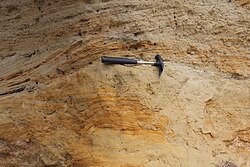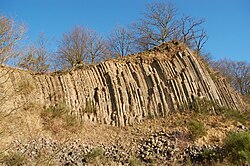Geology of Germany

The geology of Germany is heavily influenced by several phases of
Regional geological setting

Germany is located between the geologically very old (Precambrian) East European Craton (Baltica) to the north and north-east (that further north is exposed as the Baltic Shield), and the geologically young (Cenozoic) Alpine-Carpathian Orogen to the south. The corresponding crustal provinces of Germany are thus geologically "middle-aged" and were accreted onto the East European Craton during the Paleozoic through plate tectonic processes. These areas form the geological basement of Germany. The basement is the oldest of the four geological crustal levels (German: Stockwerke) that overlap in Central Europe, north of the Alps. The levels mainly reflect the age relationships of rocks and the great tectonic trends that the Earth's crust was subjected to in the course of its geological history: crustal extension and widespread, mostly marine, sedimentation alternating with crustal compression/orogeny and extensive erosion. The surface geology of Germany has evolved to its current configuration due to regional differences in the action and appearance of external and internal forces during the last c. 20 million years. Germany can be divided into three physiographic regions: the Central European Depression, the Central European Blocks and the Alps.
Physiographic regions

Central European Depression
The northern third of Germany is part of the Central European Depression (German: Mitteleuropäische Senke), also known as the North German-Polish Basin, corresponding roughly to the North German Plain. The Central European Depression is a long-term subsiding area containing a sedimentary rock sequence, several thousand metres thick, of Late Palaeozoic to Cenozoic age and is characterised by a strong surficial glacial overprint as well as salt tectonics of Permian underground salt diapirs together with minor long-range effects of the Alpine Orogeny.
Central European Blocks
South of the Central European Depression is the Central European Blocks area (German: Mitteleuropäisches Schollengebiet), which geographically includes the
Alpine-Carpathian Arc
South of the South German Block and the Bohemian Massif is the Alpine-Carpathian Arc (German: Alpen-Karpaten-Bogen). Although its extent in Germany is limited to the extreme south of
Geological levels
North of the Alps, four crustal "levels" of surface and underground rocks in Germany are traditionally distinguished by age and structural characteristics (from deep to shallow): the basement, the transition level, the Mesozoic platform and the Cenozoic platform. The latter three are also summarised under the generic term "platform", in contrast to the basement.
Basement

The basement (German: Grundgebirgsstockwerk) consists of folded rocks, some of which are
Whereas the Caledonian folded basement lies a few thousand metres below the surface of the Central European Depression, the Variscan basement or Variscides (German: Varistikum) outcrops in the Central European Blocks area, occurring extensively in several large highland areas and also sparsely in some lowland areas in the form of basement uplifts. A distinction is made here between rock complexes, commonly referred to as "slate belts" (German: Schiefergebirge) made of unmetamorphosed or weakly metamorphosed rocks (
Transition
The transition level (German: Übergangsstockwerk) includes all unfolded sedimentary and
Mesozoic platform


The Mesozoic platform (German: Mesozoisches Deckgebirge) includes all virtually unfolded sedimentary rocks of the Mesozoic (
The outcropping Mesozoic platform at the surface comprises
In northern Germany, individual blocks have been forced up by salt domes, and have been eroded down to the older layers of the Mesozoic platform. Erosion-resistant bedrock on these blocks forms small isolated ridges, especially in the northern Harz foreland region. These include the Elm hills (Muschelkalk), the Asse hills (Buntsandstein and Muschelkalk) and the Grosser Fallstein (Muschelkalk) as well as the island of Heligoland (Buntsandstein). Cretaceous chalk can be found, partly covered by thin Quaternary deposits, only in northern Germany, including in Münsterland Cretaceous Basin, where the Cretaceous deposits directly rest on the Ruhr Carboniferous and continue westward into the Aachen Formation, as well as in the Hanover and Salzgitter area. Probably the most well-known Cretaceous limestones of Germany are those on the island of Rügen, on Germany's north coast.
Cenozoic platform
The Cenozoic platform (German: Känozoisches Deckgebirge) comprises
.In northern Germany, almost the entire surface geology is made of Cenozoic sediments (mostly Pleistocene and
German Alps

The Alps are a young orogen, in which the relatively simple geological relationship between basement and platform that exists in the area north of the Alps has been overprinted and complicated by orogenic processes. The formation of the Alps happened in tectonic "domains", but within which basement and platform can be distinguished, which either jointly or separately, are built of separate nappes. The nappes outcropping in the German Alps invariably contain platform units of folded, unmetamorphosed sedimentary rocks, mainly of Mesozoic age, which were deposited almost exclusively in a marine environment. They are associated with three of the four domains of the Alps.
Helvetic domain
The
on the southern edge of pre-Alpine Europe and they were not affected by the folding and overthrusting processes of the Alpine Orogeny until relatively late.Flysch zone
The Penninic Domain (also known as the Penninic Nappes) (German: Penninikum) strikes south of the Helvetic Domain in a strip, a few kilometres wide, in the form of the Rhenodanubian Flysch Zone. It comprises Cretaceous – lower Tertiary siliciclastic-carbonate turbiditic deepwater sediments , which represent a portion of the erosion debris forming the Alpine sedimentary wedge that in the further course of formation of the Alps was itself incorporated into the orogen and overthrust over a distance of about 100 km to the north onto the Helvetic units.[8]
Limestone Alps

The Eastern Alps strike south of the Flysch Zone and occupy the largest area in the German Alps. In Germany, the Eastern Alps are, for the most part, Mesozoic mostly Triassic carbonate rocks. This carbonate rock association, whose outcrop (including the Austrian parts) runs in a 35 to 50-kilometre-wide strip from Vorarlberg as far as the Vienna Basin, is called the Northern Limestone Alps. In contrast to the Helvetic Domain and the Flysch Zone that still mostly have a low mountain character (German: Mittelgebirge) although they are morphologically clearly set apart from the Alpine foreland, the Northern Limestone Alps form high mountains (German: Hochgebirge) of well over 2,000 metres above sea level. Of the high mountains of Germany, the highest is Zugspitze, with a height of 2,962 metres, more than a thousand metres higher than Feldberg in the Black Forest, Germany's highest mountain outside the Alps.
The Northern Limestone Alps represent a depositional environment that was probably located several hundred kilometres to the south, relative to the current position of the rocks. This is reflected in facies as well as in the fossil record: While in the Eastern Alps platform carbonates with tropical faunas were established during the late Middle Triassic, the contemporary, epicontinental, partly terrestrial sequences in Central Europe north of the Alps are rather dominated by siliciclastics and had rather warm temperate faunas. Therefore, especially with regard to the formation of Triassic rocks, a distinction is made between "Germanic facies" (Central Europe north of the Alps) and "Alpine facies" (Northern Limestone Alps). Starting from the Late Cretaceous, the Eastern Alps were affected by the Alpine Orogeny and the rocks of the Northern Limestone Alps were stacked and transported northwards to their present position, overriding the Helvetic and Penninic domains.
See also
- European Cenozoic Rift System
- Geography of Germany
- Geology of the Alps
- Germanic Trias
- Laacher See
- List of earthquakes in Germany
- List of fossiliferous stratigraphic units in Germany
- List of sedimentary formations in Germany
- Messel pit
- Nördlinger Ries
- Rhine Gorge
- Solnhofen limestone
- Volcanic Eifel
Notes
- claystoneis covered. The colour of gaizes varies between grey beige and gold beige. In addition, gaize often has a characteristic spotted appearance.
References
- .
- ^ "Geologische Landesübersicht Sachsen-Anhalt" [Geological overview of the state of Saxony-Anhalt]. Landesportal Sachsen-Anhalt (in German). Landesamt für Geologie und Bergwesen, Land Sachsen-Anhalt. Retrieved 26 January 2021.
- ISBN 978-3-642-63960-9
- ISBN 978-951-690-913-7
- ISBN 978-3-515-06897-0.
- PMID 26346423.
- ^ "Stratigraphische Tabelle von Deutschland 2016 (Stratigraphic Chart of Germany 2016 – 2nd edition)" (PDF). Deutsche Stratigraphische Kommission. July 2016. Retrieved 24 September 2019.
- ISBN 978-0813700229
Bibliography
- Deutsche Stratigraphische Kommission (2002) Stratigraphische Tabelle von Deutschland 2002, Potsdam, ISBN 3-00-010197-7(in German)
- Dierk Henningsen, Gerhard Katzung (2006) Einführung in die Geologie Deutschlands 7th edition, Munich, Spektrum Akademischer Verlag, ISBN 3-8274-1586-1(in German)
- Roland Walter (1995) Geologie von Mitteleuropa. 6th edition, Stuttgart, E. Schweizerbart’sche Verlagsbuchhandlung, ISBN 978-351-0-65167-2(in German)
External links
- "Lithostratigraphische Einheiten Deutschlands" (Lithostratigraphic Units of Germany) (in German). LithoLex. Retrieved 24 September 2019.
- "Stratigraphische Tabelle von Deutschland 2016" (Stratigraphic Chart of Germany 2016), Potsdam, Deutsche Stratigraphische Kommission ISBN 978-3-9816597-7-1. Retrieved 19 March 2019.
- Nationaler Geotop – List of the most notable geological localities in Germany. (in German) Retrieved 18 April 2024.




